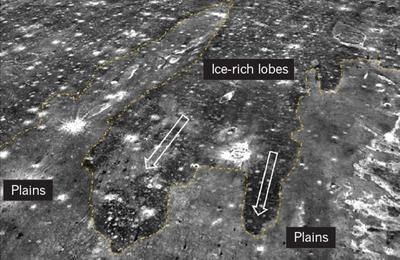A giant asteroid impacts could have raised waves of more than 100 meters high there are 3.4 billion years.
The Mars history has not been easy. At least two extremely violent tsunami swept the surface of the planet there are about 3.4 billion years, according to a paper published Thursday, May 19 in the journal Scientific Reports . These two disasters exceeded in intensity that can cause even the most powerful earthquakes, and were caused by the collapse of giant asteroids leaving crater 30km wide at the bottom of the Martian ocean dried up today, producing waves 120 meters high, and flooding the coast up to 600 km from shore.
“this is a bold hypothesis, which has important implications on what the Martian history is known including the presence of an ocean at that time, “said Nicolas Mangold, CNRS researcher specializing Mars Planetary Geodynamics Laboratory and the University of Nantes. has long been known, and recent missions of the European Space Agency (ESA) and NASA have confirmed that the Martian climate has in the past been warmer and that large amounts of water flowed a time on the surface of the planet. But the idea that Mars could maintain for long periods of a great ocean, before the planet loses its atmosphere and cools, the subject of much debate among planetary scientists.
The shores scattered by the waves
space observations bring yet more arguments to say that in an ancient past, around 3.8 billion years, much of the current northern hemisphere of Mars was covered an ocean. This is what shows the topography of the planet, with high plateaus old (very cratered, and therefore little altered since their formation) in the southern hemisphere and lower plains and newer (less cratered) north and the presence of many debacle channels carved by catastrophic floods whose flow would fill the ocean in the northern hemisphere.
Limits shorelines of the Martian ocean at the time of the two tsunamis (in blue) on the left, the deposits left by both disasters (brown) to the right Photo credits:. ALEXIS RODRIGUEZ / AFP
But the absence of clear shore line around the edges of this ancient body of water was doubt some specialists. “Our discovery provides a simple solution to this problem. The shores of ancient Martian oceans were dispersed at very different altitudes by tsunamis, “says Alexis Rodriguez, a researcher at the Planetary Science Institute in Tucson, Arizona, and first author of the publication.
Researchers are based on morphological analysis of land on the border between the southern highlands and the lowlands of the north, with high resolution pictures made by probes in orbit around the planet . They observe in particular long lobed structures, several hundred kilometers long, which appear to date from the slopes. “I am very excited to see this American publication, which goes exactly in the same sense that a study that I am leaving this topic enthuses François Costard, Martian geomorphology specialist at the CNRS (in Université Paris-Sud). We studied the same type of structures, and the only phenomenon that explains a feed which pulls slopes in this manner is a tsunami. I would like to have other explanations, but I see nothing. “
An important ocean to the search for life traces
The American study also describes runoff, which are linked to any river system or upstream channel debacle, which are characteristic of a reflux after the passage of a tidal wave. The shapes of the structures studied on Mars correspond to much larger scales, which was observed on Earth after the tsunamis in Indonesia in 2004 and Japan in 2011.

The darker lobes are structures that date back slope (white arrows) and contain more ice than the surroundings . Copyright: Alexis Rodriguez
Alexis Rodriguez and his colleagues even see traces of two separate disasters, separated by a few million years. And the structures they observe them suggest that during the most recent tidal wave, the ocean was covered with a thin layer of ice, which was broken and washed away by the energy of the giant wave.
the passages of giant waves that have strongly marked the landscape show in any case an extended ocean was still present there are 3.4 billion years, much later than the period previously accepted which was around 3.8 billion years. A parameter that may be important for all life forms on Mars research, whose appearance requires the presence of liquid water for extended periods. “As the asteroid of this size impacts are not so common, it also suggests that this ocean has remained in place for very long periods, which would also be a surprise as recently, when the planet was already have cooled sharply “says Nicolas Mangold. “We do not understand how the climate of the time could allow the maintenance of a liquid water ocean, but it is precisely the interest of this type of study: produce observational clues to investigate “adds François Forget, a planetary scientist at the Dynamic Meteorology Laboratory (CNRS / Ecole Polytechnique / ENS / UPMC). “The comments are always right, even if their interpretation is sometimes difficult.”
No comments:
Post a Comment